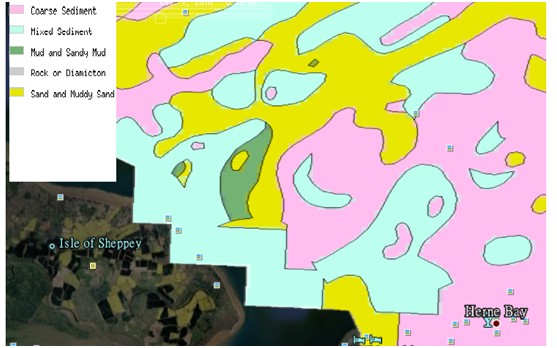Marine Geology factors in airport construction
Paper代写范文:“Marine Geology factors in airport construction”,这篇论文主要描述的是在机场的建设中我们有时候需要考虑海洋地质的因素,以谢佩岛的机场建设为例,机场的建设就需要通过大面积的填海来实现,海洋当中存在着海底沉淀物,因此在建设的前期我们需要进行综合分析,思考解决海洋地质问题和地基处理的方式。

Due to restrictions on our airport proposal from surrounding protected and SSSI areas, and the proximity to urban areas, a large area of offshore reclamation will also be required for the airport, and as such it is important to understand the geology of the estuary floor.
Figure 21
The low resolution image above, from the Onegeology webmap, shows the seabed sediments near Isle of Sheppey. Prior to the reclamation land construction, a comprehensive analysis is required in order to model and assess the behaviour of the platform during and after the construction period, as well as to calculate the volume both for soft sedimentation dredged from the site and the filled material. In order to create a framework that indicates the spatial distribution of geological formation in each of the reclamation sites, the following critical data and information is required: (27)
- the distribution of the soft compressible sediment
-base levels for dredging soft sedimentation from platform site
-identification of drainage pathways under the reclamation
-identification of areas that need ground treatment and chose the suitable method such as surcharge and dynamic compaction
The most widely used method in geological assessment is to use High Resolution Seismics – this is the most economical method for studying the first 100 meters of soil beneath the seafloor. It can determine the sedimentation structure by using devices such as sediment sounders, boomers and sparkers. (28) The offshore data from the webGIS of BGS (British Geological Survey) shows that the Quaternary deposit which forms the top of the seabed has a thickness of less than 50m in South and Southeast of England; therefore the High Resolution Seismics method can be successfully applied.
The approach adopted in building Chek Lap Kok airport provides guidance which could be followed when carrying out a more detailed investigation for the area of reclaimed land. The extensive site investigation undertaken there employed a ‘boomer acoustic source’, operating to depths of 100m, apart from the area where there is a small network of channels, which would cause acoustic turbidity on seismic records. To calibrate and confirm the lithological and geological data provide by the seismic interpretation, a suite of 3202 dredge-level CPTs were carried out combined with extensive borehole sampling. Once the sediment structure was identified, the superficial stiff mud layer, averaging 7.5m in thickness, could be dredged and used for the land reclamation.
Ground treatment methods
During the construction, an excavation of 15 to 20m depth will be required in order to provide space for sub-ground levels of the major Terminal buildings. Other buildings will also require some level of excavtion, so it becomes necessary to know the influence of the swelling on the behaviour of soil beneath. Much research has been carried out on London clay, and the research which carried out during the planning of Heathrow Terminal 5 provides us the evidence that no negative effect will be cause by excavation up to 25min depth onshore. (29)
In order to minimize the total and differential settlement of structure, ground improvement is required. For construction of large scale structures such as airport terminal buildings, ground treatments are often required prior to the construction of runways and the foundation of terminal facilities. For reclaimed land on sea, ‘drainage’ methods can be used to accelerate the rate of consolidation of soft mud; or dredge and fill methods, as with Chek Lap Kok, can also be supplemented with dynamic compaction. For us to select the appropriate treatment methods, the potential problems first need to be identified. The effectiveness of different ground treatment methods have been summarized by Watts and Charles in 1997. (29) For preloading, a relative large area is needed for the process to be practical and the costs can be high. The dynamical compaction is effective although it causes most compression in top 5-6 only and reduces much of the immediate settlement but not the long-term settlement. However, the cost for dynamic compaction has been compared with other form of ground improvement (preloading, jet grouting, vibrated concrete columns, etc.) and this showed dynamic compaction to be significantly cheaper than other forms of site improvement. (30)
On land, we suggest using dynamic compactions method, unless the detailed geological analysis shows the ground improvement must be attained at depth greater than 9m, for which we will use the combination of dynamic compaction with other systems such as a combination of wick drains and surcharge plus dynamic compaction. The potential methods of ground treatment used in reclamation will be pumping, surcharge, vibro-compaction and dynamic compaction.
51due留学教育原创版权郑重声明:原创留学生作业代写范文源自编辑创作,未经官方许可,网站谢绝转载。对于侵权行为,未经同意的情况下,51Due有权追究法律责任。
51due为留学生提供最好的悉尼paper代写服务,亲们可以进入主页了解和获取更多paper代写范文以及留学生在线TA服务,详情可以咨询我们的客服QQ:800020041哟。-xz